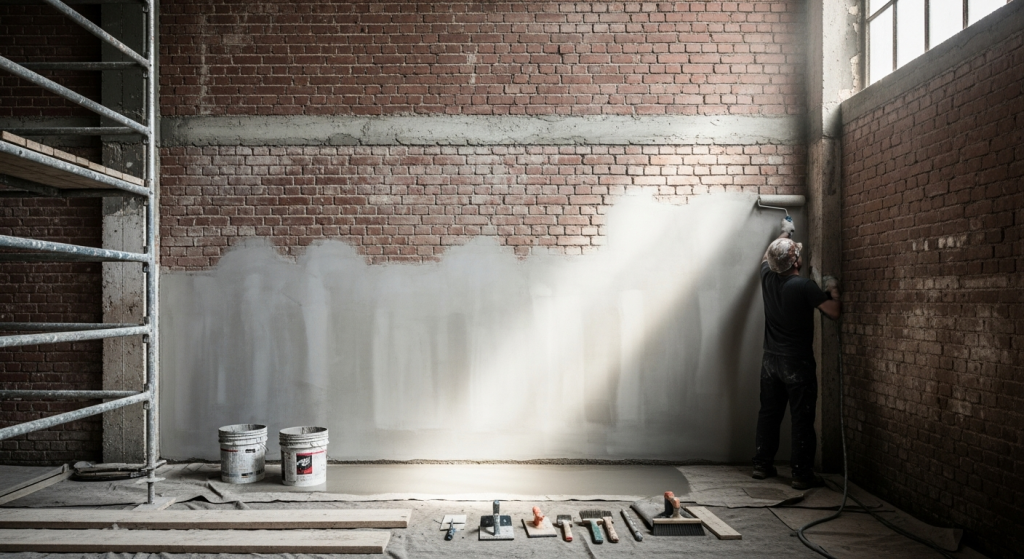
Industrial and factory environments are no longer limited to purely functional designs; contemporary styles blend visual appeal with durability, safety, and practicality. Selecting appropriate wall finishing and painting methods can greatly enhance the atmosphere, safety protocols, and maintenance effectiveness in industrial contexts.
1. Epoxy Coatings for Tough Durability
Epoxy paint is a staple in industrial environments due to its excellent adhesion, chemical resistance, and toughness. It withstands heavy machinery, foot traffic, and exposure to oils or chemicals, making it ideal for manufacturing floors, walls near machinery, and storage areas. Newer epoxy formulations in 2025 feature faster drying times and improved wear resistance.
2. Anti-Graffiti and Easy-to-Clean Finishes
Industrial environments frequently encounter issues such as vandalism or the accumulation of dirt, which renders anti-graffiti and high-cleanability coatings crucial. These sophisticated coatings facilitate the swift elimination of stains, graffiti, or dust, ensuring a tidy and professional look with little effort. Additionally, innovations encompass antimicrobial paints that contribute to enhanced hygiene in communal areas.
3. Exposed Concrete or Gunite Finishes
Numerous factories adopt the raw industrial aesthetic by either leaving walls unpainted or utilizing textured finishes such as gunite or polished concrete. These surfaces are not only durable and low-maintenance but also cost-effective, offering outstanding fire resistance and thermal mass properties that contribute to the maintenance of stable indoor temperatures.
4. High-Visibility Safety Markings
Utilizing robust, high-contrast paint for safety markings on walls, pathways, and hazardous areas is essential in industrial environments. Fluorescent or reflective paints increase visibility in different lighting conditions, thereby contributing to enhanced workplace safety and compliance with regulatory requirements.
5. Industrial-Grade Wall Panels with Protective Coatings
In settings where moisture, chemicals, or regular cleaning are prevalent, wall panels that are insulated or antimicrobial and finished with specialized coatings offer both protection and hygiene. Additionally, these panels enhance thermal insulation and simplify maintenance.
6. Thermally Insulating Paints
To boost energy efficiency, thermally insulating paints can be applied to large factory walls and ceilings, helping reduce heating and cooling costs by reflecting heat and improving thermal retention inside the building.
7. Color Coding for Workflow and Safety
Applying color-coded paint zones in factories helps define workflow areas, mark safety boundaries, and organize spaces visually. This practical use of paint enhances operational clarity and worker awareness, reducing mishaps and improving productivity.
Innovative Industrial Paint Products in 2025
Eco-friendly and low-VOC paints are gaining popularity for healthier indoor air quality and sustainability.
Advanced spray systems reduce overspray and material wastage, increasing efficiency.
Anti-bacterial and antimicrobial paints prevent mold and bacteria growth, ideal for hygienic factory areas.
Self-cleaning and anti-graffiti coatings minimize maintenance and protect surfaces.
Fast-drying, durable finishes improve project timelines without sacrificing quality.
Conclusion
In 2025, industrial and factory wall finishing solutions combine functionality, durability, and safety with modern aesthetics. Selecting the right coatings—from epoxy and anti-graffiti paints to insulating and color-coded finishes—enhances operational efficiency, prolongs surface life, and improves workplace safety. Innovations in eco-friendly and antimicrobial paints also support healthier environments and sustainability goals. With these advancements, industrial spaces can be both practical and visually appealing, meeting the evolving demands of modern industry.
